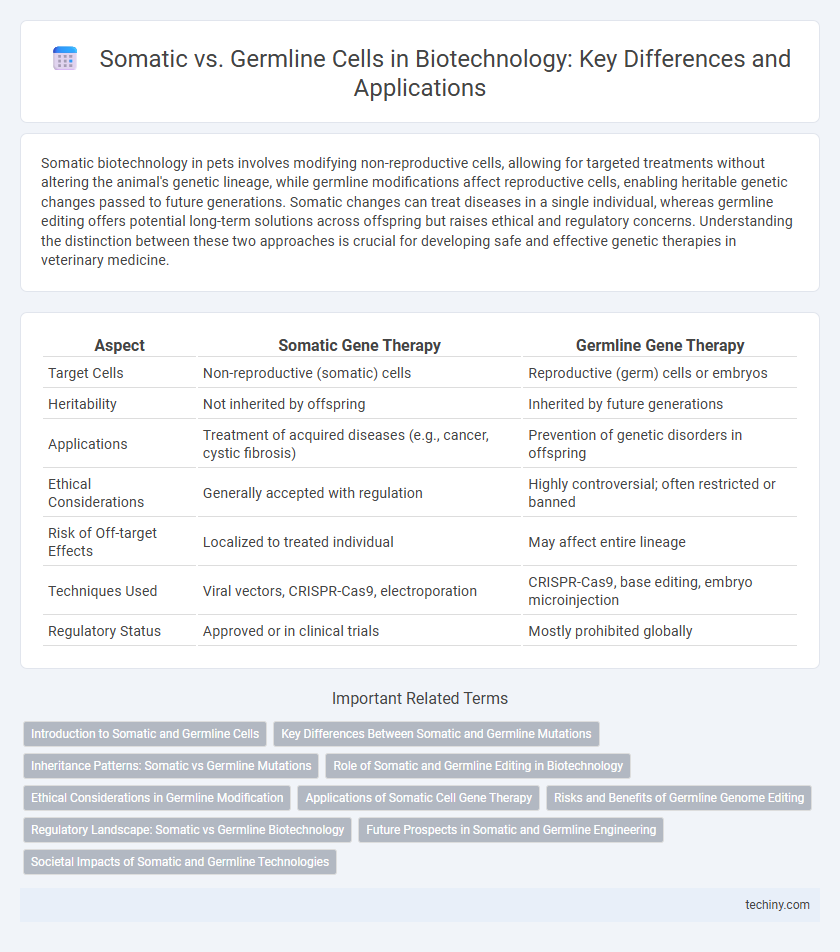Somatic biotechnology in pets involves modifying non-reproductive cells, allowing for targeted treatments without altering the animal's genetic lineage, while germline modifications affect reproductive cells, enabling heritable genetic changes passed to future generations. Somatic changes can treat diseases in a single individual, whereas germline editing offers potential long-term solutions across offspring but raises ethical and regulatory concerns. Understanding the distinction between these two approaches is crucial for developing safe and effective genetic therapies in veterinary medicine.
Table of Comparison
| Aspect | Somatic Gene Therapy | Germline Gene Therapy |
|---|---|---|
| Target Cells | Non-reproductive (somatic) cells | Reproductive (germ) cells or embryos |
| Heritability | Not inherited by offspring | Inherited by future generations |
| Applications | Treatment of acquired diseases (e.g., cancer, cystic fibrosis) | Prevention of genetic disorders in offspring |
| Ethical Considerations | Generally accepted with regulation | Highly controversial; often restricted or banned |
| Risk of Off-target Effects | Localized to treated individual | May affect entire lineage |
| Techniques Used | Viral vectors, CRISPR-Cas9, electroporation | CRISPR-Cas9, base editing, embryo microinjection |
| Regulatory Status | Approved or in clinical trials | Mostly prohibited globally |
Introduction to Somatic and Germline Cells
Somatic cells constitute all body cells except reproductive cells and are diploid, containing two sets of chromosomes inherited from both parents. Germline cells are specialized reproductive cells that give rise to gametes, carrying genetic information to offspring through haploid chromosome sets. Understanding the distinction between somatic mutations, which affect only the individual, and germline mutations, which are heritable, is crucial in biotechnology for applications like gene therapy and genetic engineering.
Key Differences Between Somatic and Germline Mutations
Somatic mutations occur in non-reproductive cells and affect only the individual, while germline mutations take place in reproductive cells and can be inherited by offspring. Somatic mutations contribute to diseases like cancer without altering the genetic information passed to the next generation, whereas germline mutations are responsible for hereditary genetic disorders. The distinction impacts therapeutic strategies, with gene editing in germline cells raising ethical considerations due to heritability, unlike somatic cell modifications focused on treating or preventing disease in the individual.
Inheritance Patterns: Somatic vs Germline Mutations
Somatic mutations occur in non-reproductive cells and are not inherited by offspring, limiting their effects to the individual organism. Germline mutations arise in reproductive cells and can be passed down to subsequent generations, influencing hereditary traits and evolutionary processes. Understanding the distinct inheritance patterns of somatic versus germline mutations is crucial for genetic counseling, disease risk assessment, and biotechnological applications in gene therapy.
Role of Somatic and Germline Editing in Biotechnology
Somatic editing targets non-reproductive cells, enabling precise treatment of diseases like cancer and genetic disorders without passing changes to offspring, making it pivotal in therapeutic biotechnology. Germline editing alters DNA in reproductive cells or embryos, offering potential to eradicate hereditary diseases but raising ethical and regulatory challenges. Both approaches drive advancements in gene therapy, personalized medicine, and biotechnological innovation by enabling control over genetic traits at different biological levels.
Ethical Considerations in Germline Modification
Germline modification raises significant ethical concerns due to its heritable nature, potentially affecting future generations without their consent. Issues such as unintended genetic consequences, equity in access, and the risk of eugenics intensify the debate within the biotechnology field. Regulatory frameworks and ethical guidelines emphasize caution, urging comprehensive risk assessment and societal dialogue before clinical application.
Applications of Somatic Cell Gene Therapy
Somatic cell gene therapy targets non-reproductive cells to treat genetic disorders such as cystic fibrosis, muscular dystrophy, and certain cancers by directly modifying or replacing defective genes in affected tissues. This approach offers potential for personalized treatments without altering the patient's germline, thereby avoiding hereditary transmission of changes. Techniques like viral vector delivery and CRISPR-Cas9 enable precise gene editing, improving therapeutic outcomes and minimizing off-target effects.
Risks and Benefits of Germline Genome Editing
Germline genome editing offers the potential to eliminate hereditary diseases by altering DNA in embryos, ensuring changes are passed to future generations and potentially reducing genetic disorders on a population scale. However, this approach carries significant risks, including unintended off-target effects, mosaicism, and ethical concerns about consent and long-term impacts on human genetics. Balancing these benefits and risks requires stringent regulatory frameworks and comprehensive scientific evaluation to ensure safe and responsible application.
Regulatory Landscape: Somatic vs Germline Biotechnology
The regulatory landscape for somatic biotechnology focuses on targeted therapies affecting individual patients without altering the germline, ensuring changes are non-heritable and compliant with established clinical safety protocols. Germline biotechnology involves inheritable modifications, prompting stricter oversight by international bodies such as the FDA, EMA, and WHO due to ethical concerns and long-term population impacts. Regulatory frameworks emphasize risk assessment, genetic counseling, and monitoring to balance therapeutic benefits against potential multi-generational consequences.
Future Prospects in Somatic and Germline Engineering
Somatic and germline engineering present transformative prospects in biotechnology, with somatic gene therapies advancing rapidly for treating genetic disorders by targeting specific tissues without altering the germline DNA. Future developments in germline engineering hold potential for heritable disease eradication and enhanced human traits, though ethical and regulatory challenges remain significant. Innovations in CRISPR and base editing technologies continue to push the boundaries of precision and safety in both somatic and germline applications, driving forward personalized medicine and genomic medicine paradigms.
Societal Impacts of Somatic and Germline Technologies
Somatic gene therapies target individual cells and tissues, enabling personalized treatments for diseases without hereditary effects, which reduces ethical concerns but limits long-term population benefits. Germline editing alters reproductive cells, posing profound societal impacts by potentially eradicating genetic disorders across generations while raising ethical debates over consent, equity, and unintended consequences. The divergence in safety, regulatory frameworks, and social acceptance highlights complex implications for public health policies and genetic equity worldwide.
Somatic vs Germline Infographic

 techiny.com
techiny.com